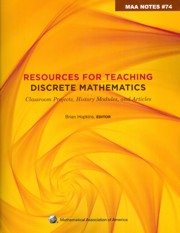Book contents
- Frontmatter
- Introduction
- Dedication
- Contents
- I Classroom-tested Projects
- The Game of “Take Away”
- Pile Splitting Problem: Introducing Strong Induction
- Generalizing Pascal: The Euler Triangles
- Coloring and Counting Rectangles on the Board
- Fun and Games with Squares and Planes
- Exploring Recursion with the Josephus Problem: (Or how to play “One Potato, Two Potato” for keeps)
- Using Trains to Model Recurrence Relations
- Codon Classes
- How to change coins, M&M's, or chicken nuggets: The linear Diophantine problem of Frobenius
- Calculator Activities for a Discrete Mathematics Course
- Bulgarian solitaire
- Can you make the geodesic dome?
- Exploring Polyhedra and Discovering Euler's Formula
- Further Explorations with the Towers of Hanoi
- The Two Color Theorem
- Counting Perfect Matchings and Benzenoids
- Exploring Data Compression via Binary Trees
- A Problem in Typography
- Graph Complexity
- II Historical Projects in Discrete Mathematics and Computer Science
- III Articles Extending Discrete Mathematics Content
- IV Articles on Discrete Mathematics Pedagogy
- About the Editor
Exploring Polyhedra and Discovering Euler's Formula
from I - Classroom-tested Projects
- Frontmatter
- Introduction
- Dedication
- Contents
- I Classroom-tested Projects
- The Game of “Take Away”
- Pile Splitting Problem: Introducing Strong Induction
- Generalizing Pascal: The Euler Triangles
- Coloring and Counting Rectangles on the Board
- Fun and Games with Squares and Planes
- Exploring Recursion with the Josephus Problem: (Or how to play “One Potato, Two Potato” for keeps)
- Using Trains to Model Recurrence Relations
- Codon Classes
- How to change coins, M&M's, or chicken nuggets: The linear Diophantine problem of Frobenius
- Calculator Activities for a Discrete Mathematics Course
- Bulgarian solitaire
- Can you make the geodesic dome?
- Exploring Polyhedra and Discovering Euler's Formula
- Further Explorations with the Towers of Hanoi
- The Two Color Theorem
- Counting Perfect Matchings and Benzenoids
- Exploring Data Compression via Binary Trees
- A Problem in Typography
- Graph Complexity
- II Historical Projects in Discrete Mathematics and Computer Science
- III Articles Extending Discrete Mathematics Content
- IV Articles on Discrete Mathematics Pedagogy
- About the Editor
Summary
Summary
The activities and exercises collected here provide an introduction to Euler's formula, an introduction to interesting related topics, and sources for further exploration. While Euler's formula applies to any planar graph, a natural and accessible context for the study of Euler's formula is the study of polyhedra.
The article includes an introduction to Euler's formula, four student activities, and two appendices containing useful information for the instructor, such as an inductive proof of Euler's theorem and several other interesting results that may be proved using Euler's theorem. Each activity includes a discussion of connections to discrete mathematics and notes to the instructor. Three of the activities have worksheets at the end of this article, followed by solutions and a template for a toroidal polyhedron.
A brief introduction to Euler's formula
Theorem (Euler's formula, polyhedral version). Let P be any polyhedron topologically equivalent to a sphere. Let V be the number of vertices, E the number of edges and F the number of faces of P. Then V - E + F = 2.
A graph is said to be a simple graph if it is an undirected graph containing neither loops nor multiple edges. A graph is a plane graph if it is embedded in the plane without crossing edges. A graph is said to be planar if it admits such an embedding.
- Type
- Chapter
- Information
- Resources for Teaching Discrete MathematicsClassroom Projects, History Modules, and Articles, pp. 97 - 116Publisher: Mathematical Association of AmericaPrint publication year: 2009
- 1
- Cited by

